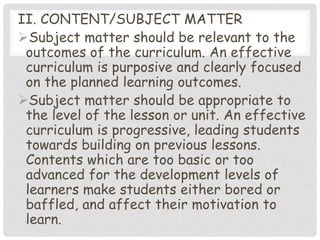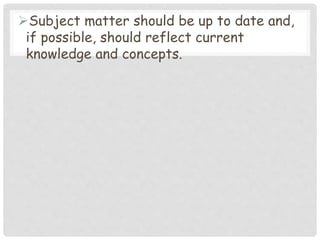Chapter 2
- 2. MODULE 3: The teacher as a curriculum designer
- 4. Building on Peter Oliva’s 10 Axioms for Curriculum Designed 1. Curriculum change is inevitable, necessary, and desirable. 2. Curriculum is a product of its time. 3. Curriculum changes made after earlier can exist concurrently with newer curriculum changes. 4. Curriculum change depends on people who will implement the change. 5. Curriculum development is a cooperative group activity.
- 5. 6.Curriculum development is a decision- making process made from choices of alternatives. 7.Curriculum development is an ongoing process. 8. Curriculum development is more effective if it is a comprehensive process, rather than a “piecemeal”. 9.Curriculum development is more effective when it follows a systematic process. 10.Curriculum development starts from where the curriculum is.
- 7. I. BEHAVIORAL OBJECTIVES OR INTENDED LEARNING OBJECTIVES Begin with the end in view. The objectives or intended learning outcomes are the reasons for undertaking the learning lesson from the student’s point of view; it is desired learning outcome that is to be accomplished in a particular learning episode, engaged in by the learners under the guidance of the teacher. As a curriculum designer, the beginning of the learning journey is the learning outcomes to be achieved. In this way, both the learner and the teacher are guided by what to accomplish.
- 8. II. CONTENT/SUBJECT MATTER Subject matter should be relevant to the outcomes of the curriculum. An effective curriculum is purposive and clearly focused on the planned learning outcomes. Subject matter should be appropriate to the level of the lesson or unit. An effective curriculum is progressive, leading students towards building on previous lessons. Contents which are too basic or too advanced for the development levels of learners make students either bored or baffled, and affect their motivation to learn.
- 9. Subject matter should be up to date and, if possible, should reflect current knowledge and concepts.
- 10. III. REFERENCES The reference follows the content. It tells where the content or subject matter has been taken. The reference may be a book, a module, or any publication. It must bear the author of the material and if possible, the publications. Example: Shipman, James and Jerry Wilson, et. Al (2009). An introduction to Physical Science. Houghton Mifflin Co. Boston MA
- 11. IV. TEACHING and Learning Methods Cooperative learning activities allow students to work together. Students are guided to learn on their own to find solutions to their problems. The role of the teachers is to guide the learners. Democratic process is encouraged, and each one contributes to the success of learning. Students learn from each other in ways. Group projects and activities considerably enhance the curriculum.
- 12. Independent learning activities allow learners to develop personal responsibility. The degree of independence to learn how to learn is enhanced. This strategy is more appropriate for fast learners. Competitive activities, where students will test their competencies against another in a healthy manner allow learners to perform to their maximum. Most successful individuals in their adult life are competitive, even in early schooling. They mostly become the survivors in a very competitive world. The use of various delivery modes to provide learning experiences is recommended. Online learning and similar modes are increasingly important in many curricula, but these need to be planned carefully to be effective.
- 13. V. ASSESSMENT/ EVALUATION Self assessment, through which students learn to monitor and evaluate their own learning. This should be a significant element in the curriculum because we aim to produce graduates who are appropriately reflective and self-critical. Peer assessment, in which students provide feedback on each other’s learning. This can be viewed as an extension of self assessment and presupposes trust and mutual respect. Research suggest that students can learn to judge each other’s work as a reliably as staff. Teacher assessment, in which the teacher prepares and administers test and gives feedback on the student’s performance.
- 14. LESSON 2 Approaches to curriculum design
- 15. Types of Curriculum Design Method 1. Subject-Centered Design This is a curriculum design that focuses on the content of the curriculum. The subject-centered design corresponds mostly to the textbooks because textbooks are usually written based the specific subject or course.
- 16. Subject-centered curriculum design has also some variations which are focused on the individual subject, specific discipline and a combination of subjects or disciplines which are a broad field or interdisciplinary.
- 17. 1.1 Subject design is the oldest and so far the most familiar design for teachers, parents and other laymen. 1.2 Discipline Design this curriculum design model is related to the subject design. However, while subject design centers only on the cluster, discipline design focuses on the academic disciplines. 1.3 Correlation design coming from a core, correlated curriculum design links separate subject designs in order to reduce fragmentation. Subjects are related to one another and still maintain their identity. 1.4 broad field design/ interdisciplinary is a variation of the subject-centered design. This design was made to cure the compartmentalization of the separate subjects and integrate the contents that are related to one another.
- 18. 2. Learner-Centered Design Among the progressive educational psychologists, the learner is the center of educative process. This emphasis is very strong in the elementary level, however; more concern has been placed on the secondary and even the tertiary levels. Although in high school, the subject or content has become the focus and in the college level, the discipline is the center, both levels still recognize the importance of the learner in the curriculum.
- 19. 2.1 Child-centered design. This design is often attributed to the influence of John Dewey, Rouseau, Pestalozzi and Froebel. This Curriculum design is anchored on the needs and interests of the child. 2.2 Experience-centered design. This design is similar to the child-centered design. Although the focus remains to be the child, experience-centered designs believes that the interests and needs of learners cannot be pre-planned. Instead, experiences of the learners become the starting point of the curriculum, thus the school environment is left open and free. 2.3 Humanistic design. In this curriculum design, the development of self is the ultimate objective of learning. It stresses the whole person and the integration of thinking, feeling and doing. It considers the cognitive, affective and psychomotor domains to be interconnected and must be addressed in the curriculum. It stresses the development of positive self-concept and interpersonal skills.
- 20. 3. Problem-Centered Design Generally, problem-centered design draws on social problems, needs, interest and abilities of the learners. Various problems are given emphasis. There are those that center on life situations, contemporary life problems, areas of living and many others. In this curriculum, content cuts across subject boundaries and must be based on the needs, concerns and abilities of the students.
- 21. 3.1 Life-situations design. In this curriculum design, the contents are organized in ways that allow students to clearly view problem areas. It uses the past and the present experiences of learners as a means to analyze the basic areas of living. 3.2 Core problem design. It centers on general education and the problems are based on the common human activities. The central focus of the core design includes common needs, problems, and concerns of the learner.
- 22. Ways on how to proceed using core design of a curriculum (Faunce and Bossing in 1959)
- 23. Step 1. Make group consensus on important problems. Step 2. Develop criteria for selection of important problem Step 3. State and define the problem. Step 4. Decide on the areas of study, including class grouping. Step 6. Obtain and organize information for resources. Step 7. Analyze and interpret the information. Step 8. State the tentative conclusions. Step 9. Present a report to the class individually or by group. Step 10. Evaluate the conclusions. Step 11. Explore other avenues for further problem solving.
- 25. Child or Learner-centered Approach. This approach to curriculum design is based on the underlying philosophy that the child or the learner is the center of the educational process. Principles of Child-Centered Curriculum Approach 1. Acknowledge and respect the fundamental rights of the child. 2. Make all activities revolve around the overall development of the learner. 3. Consider the uniqueness of every learner in a multicultural classroom. 4. Consider using differential instruction or teaching. 5. Provide a motivating supportive learning environment for all the learner.
- 26. Subject-Centered Approach. This is anchored on a curriculum design which prescribes separate distinct subjects for every educational level: basic education, higher education or vocational-technical education. This approach consider the following principles: 1. The primary focus is the subject matter. 2. The emphasis is on bits and pieces of information which may be detached from life. 3. The subject matter serves as a means of identifying problems of living. 4. Learning means accumulation of content, or knowledge. 5. Teacher’s role is to dispense the content.
- 27. Problem-Centered Approach. This approach is based on a design which assumes that in the process of living, children experience problems. Thus, problem solving enables the learners to become increasingly able to achieve complete or total development as individuals. This approach is characterized by the following views and beliefs. 1. The learners are capable of directing and guiding themselves in resolving the problems, thus developing every learner to be independent. 2. The learners are prepared to assume their civic responsibilities through direct participation in different activities. 3. The curriculum leads the learners in the recognition of concerns and problems in seeking solutions. Learners are problem solvers themselves.
- 29. Curriculum mapping is a process or procedure that follows curriculum designing. It is done before curriculum implementation or the organization of the written curriculum. This process was introduced by Heidi Hayes Jacob in 2004 in her book Greeting Results with Curriculum Mapping (ASCD, 2004). This approach is an ongoing process or “work-in-progress”. It is not a one time initiative but a continuing action which involves the teacher and other stakeholders, who have common concerns. Curriculum mapping can be done by teachers alone, a group of teaching the same subject, the department, the whole school or district or the whole educational system.
- 30. THE CURRICULUM MAP Curriculum maps are visual timelines that outline desired learning outcomes to be achieved, contents, skills and values taught, instructional time, assessment to be used, and the overall student movement towards the attainment of the intended outcomes. Curricular maps may be simple or elaborate that can be used by individual teacher, a department, the whole school or educational system. A map is geared to be a school calendar.
- 31. Curriculum maps provide quality control of what are taught in school to maintain excellence, efficiency and effectiveness. It is intended to improve instruction and maintain quality of education that all stakeholders need to be assured. Parents, teachers and the whole educational community can look at the curriculum map to see that intended outcomes and content are covered. A map can reassure stakeholders specific information for pacing, and alignment of the subject horizontally or vertically. It will also avoid redundancy, inconsistencies and misalignment. Courses that are not correctly aligned will allow teachers to quickly assess the mastery of the skills in the previous grade, to avoid necessary reteaching.
- 32. A curriculum map is always a work in progress, that enables the teacher or the curriculum review team to create and recreate the curriculum. It provides a good information for modification of curriculum, changing of standards and competencies in order to find ways to build connections in the elements of the curricula.
































